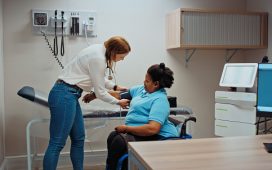Chronic diseases such as diabetes, heart disease, and hypertension require ongoing management and monitoring to ensure optimal health outcomes. However, traditional healthcare models often fall short when it comes to providing regular and personalized care to individuals with chronic conditions. That’s where telemonitoring comes in. Telemonitoring, also known as remote patient monitoring, is revolutionizing the way chronic diseases are managed, offering a new level of patient care and support. In this blog post, we will explore how telemonitoring is transforming chronic disease management.
What is Telemonitoring?
Telemonitoring involves the use of technology to remotely monitor and collect patient data such as vital signs, medication adherence, and symptoms. This data is transmitted securely to healthcare providers, who can then use it to track patients’ health status and intervene proactively if necessary. Telemonitoring typically relies on wearable devices, mobile apps, and other digital tools that patients can use from the comfort of their own homes.
Benefits of Telemonitoring
Telemonitoring offers a range of benefits for both patients and healthcare providers:
- Improved Patient Engagement: Telemonitoring empowers patients to take an active role in managing their health. By regularly monitoring their vital signs and symptoms, patients become more aware of their condition and can make informed decisions in consultation with their healthcare team.
- Better Disease Management: Telemonitoring enables healthcare providers to closely monitor patients’ health status and intervene early if any issues arise. This proactive approach can prevent medical complications, reduce hospital readmissions, and improve overall disease management.
- Enhanced Access to Care: Telemonitoring eliminates geographical barriers, allowing individuals in remote areas or those with limited mobility to receive high-quality care. Patients can connect with their healthcare providers virtually, reducing the need for frequent in-person visits.
- Cost Savings: By avoiding unnecessary hospital visits and reducing healthcare utilization, telemonitoring can lead to significant cost savings for both patients and healthcare systems.
- Personalized Care Plans: With real-time access to patient data, healthcare providers can develop personalized care plans tailored to each individual’s needs. This individualized approach improves treatment outcomes and patient satisfaction.
Successful Telemonitoring Applications
Telemonitoring has proven to be effective in managing a variety of chronic diseases:
- Diabetes: Telemonitoring allows individuals with diabetes to track their blood sugar levels, medication adherence, and lifestyle factors such as diet and exercise. Healthcare providers can remotely monitor this data and provide guidance on self-management techniques, leading to improved blood sugar control and reduced risk of complications.
- Heart Disease: Telemonitoring can be used to monitor vital signs such as blood pressure, heart rate, and oxygen levels in individuals with heart disease. Early detection of abnormalities allows healthcare providers to adjust medications and treatment plans accordingly, minimizing the risk of cardiac events.
- Hypertension: Telemonitoring enables individuals with hypertension to measure and record their blood pressure readings regularly. This data provides healthcare providers with valuable insights into blood pressure trends and helps in adjusting medication doses or recommending lifestyle modifications.
- Pulmonary Conditions: Telemonitoring can assist patients with chronic respiratory conditions such as asthma or chronic obstructive pulmonary disease (COPD). Tracking symptoms and lung function remotely allows healthcare providers to intervene promptly and provide guidance on medication adjustments and self-care strategies.
Conclusion
Telemonitoring has emerged as a powerful tool in chronic disease management, transforming patient care and promoting better health outcomes. By remotely monitoring vital signs, symptoms, and other relevant health data, telemonitoring offers a personalized and proactive approach to chronic disease management. The benefits of telemonitoring include improved patient engagement, enhanced access to care, better disease management, and cost savings. As technology continues to advance, telemonitoring is expected to play an even more significant role in revolutionizing the way chronic diseases are managed, ultimately improving the quality of life for individuals with chronic conditions.








